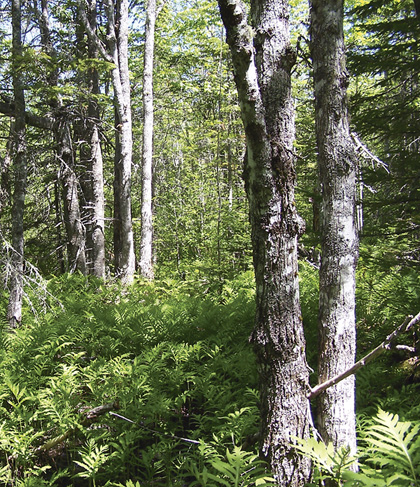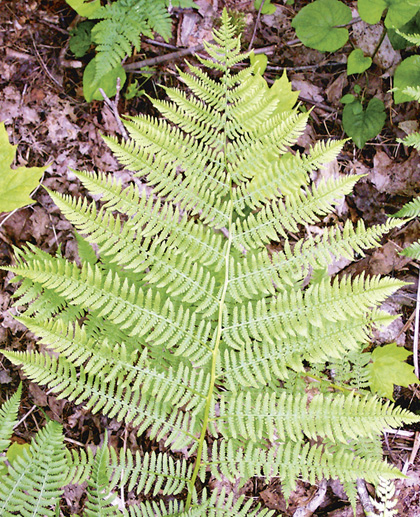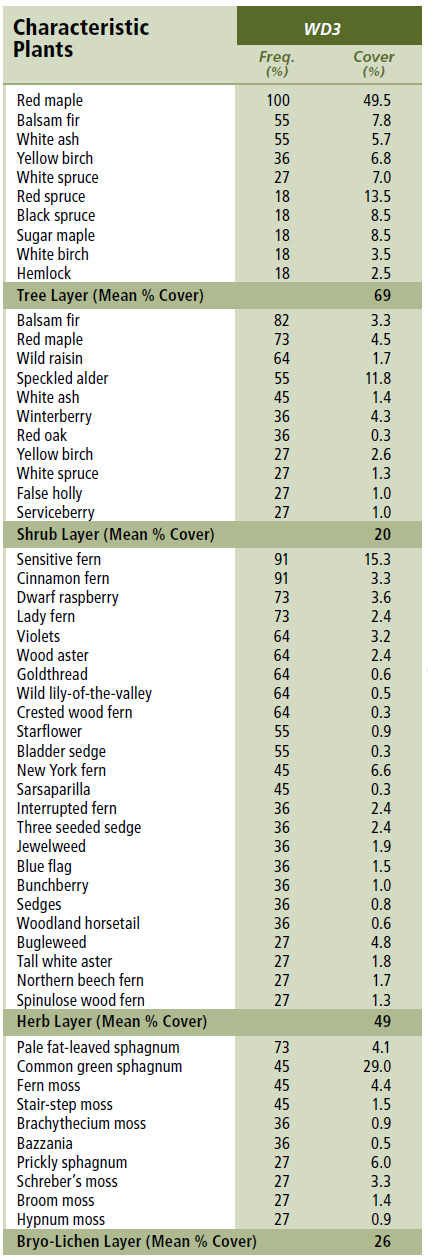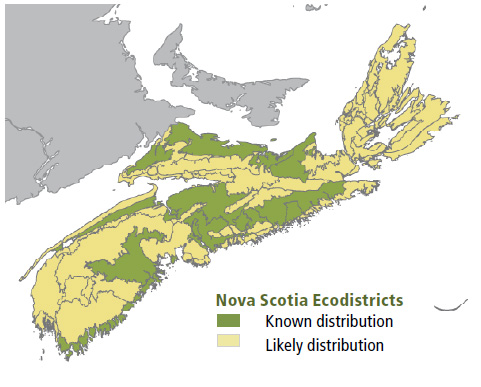
Forest Vegetation types - WD3
WD3 — Red maple / Sensitive fern – Lady fern / Sphagnum
Acer rubrum / Onoclea sensibilis – Athyrium filix-femina / Sphagnum spp.
 |
Wallace Bay, Cumberland County |
Concept: The relatively common Red maple / Sensitive fern - Lady fern / Sphagnum is one of three wet red maple forests (WD2, WD3 and WD4) in Nova Scotia. This low elevation ecosystem is more nutrient and species rich than WD2, and it lacks the Atlantic Coastal Plain flora that characterize WD4. It is usually found on peat or poorly to very poorly drained mineral deposits, persisting as an edaphic climax. The forest is characterized by red maple canopy dominance and a species-rich herbaceous understory.
Vegetation: The closed canopy is strongly dominated by red maple with far less prominent amounts of black spruce, white birch and balsam fir. The woody understory is sparse and largely comprised of regenerating canopy species with frequent but low levels of balsam fir and wild raisin. Herbaceous and bryophyte cover are less than levels reported for other deciduous wet forests of Nova Scotia, but moderately species-rich. Notable species include sensitive fern, lady fern, dwarf raspberry and pale fat-leaved sphagnum.
Environmental Setting: Flats, shallow depressions and, less often, lower positions of gentle slopes provide suitable habitat. Sites have low to moderate exposure with little microtopography, exposed bedrock or surface stoniness. The low elevation ecosystem develops on both organic deposits and poorly drained mineral soil of varied origin and texture. Glacial and post-glacial river and lake plains are common landforms. Enriched surface and/or ground water inputs provide moderate to high nutrient availability. This Vegetation Type (VT) is found scattered throughout provincial lowlands and uplands, but is particularly prominent in the Northumberland/Bras d’Or and Eastern ecoregions. WD3 is common on Prince Edward Island and across south and central New Brunswick.
Successional Dynamics: This forest can be expressed at a variety of successional stages, but is typically mid-successional. It is a type of edaphic climax and is expected to persist as described, although, depending on disturbances and nearby seed sources, it could transition to WD7 (Balsam fir – White ash / Cinnamon fern – New York fern / Sphagnum) or WD8 (Red spruce – Red maple / Wood sorrel – Sensitive fern / Sphagnum). Windthrow and harvesting are the main stand-level disturbance agents but between these, tree senescence and other minor disturbances can promote development of uneven-aged stands.
Ecological Features:This is the richest red maple wet forest in Nova Scotia, and the second richest among all wet deciduous forests, after WD1. Productivity is high but this potential may not be fully expressed by either tree height or age, both of which tend to be limited by saturated conditions. Like all wet deciduous forests, soil and groundwater nutrient richness increases understory development, species diversity and associated habitat structures. Few rare plants (e.g. meadow horsetail, black ash) are documented but the ecosystem provides valuable habitat for numerous species (e.g. as an important early source of nectar and pollen). Small pools or tracts of standing water are common in the spring and early summer, but usually dry up later. Canopy tree senescence and uprooting are relatively common, and are often followed by vigourous stump sprouting. This process may support a uniquely persistent and poorly understood form of old growth.
 |
| Lady fern |
Distinguishing Features: Red maple dominates this poorly drained hardwood forest which has a better developed herb layer compared to WD2. Nutrient demanding herbs in the understory include sensitive fern, lady fern and dwarf raspberry. Pale fat-leaved sphagnum and common green sphagnum are common.
| Slope Position: | Level6 Depression3 Middle1 |
Surface Stoniness: |
(Non - Slightly)10 |
Bedrock Outcrop: |
(Non-rocky)10 |
Elevation Range: |
2 - 112m |
Slope Gradient: |
Level9 nd1 |
Aspect: |
West1 None9 |
Exposure: |
Moderate5 Mod. sheltered3 Mod. exposed1 nd1 |
Microtopography: |
Level5 Slightly4 nd1 |
Drainage: |
Poor8 Very poor2 |
Soil Type: |
ST43 ST143 ST102 ST71 ST91 |
Parent Material: |
Organic4 Glacial till3 Lacustrine2 Alluvium1 |
Rooting Depth (cm): |
(<30)7 nd3 |
Duff Thickness (cm): |
(0-5)1 (11-20)2 (21-40)2 (>40)1 nd4 |

